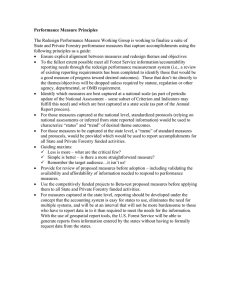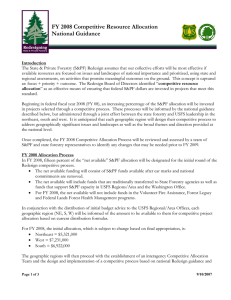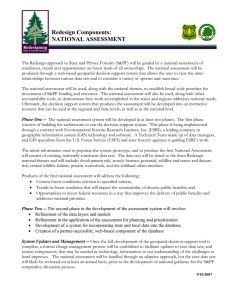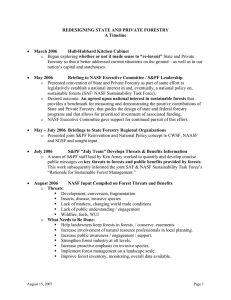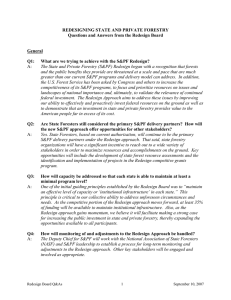Redesign Components: DEMONSTRATING & COMMUNICATING RESULTS
advertisement
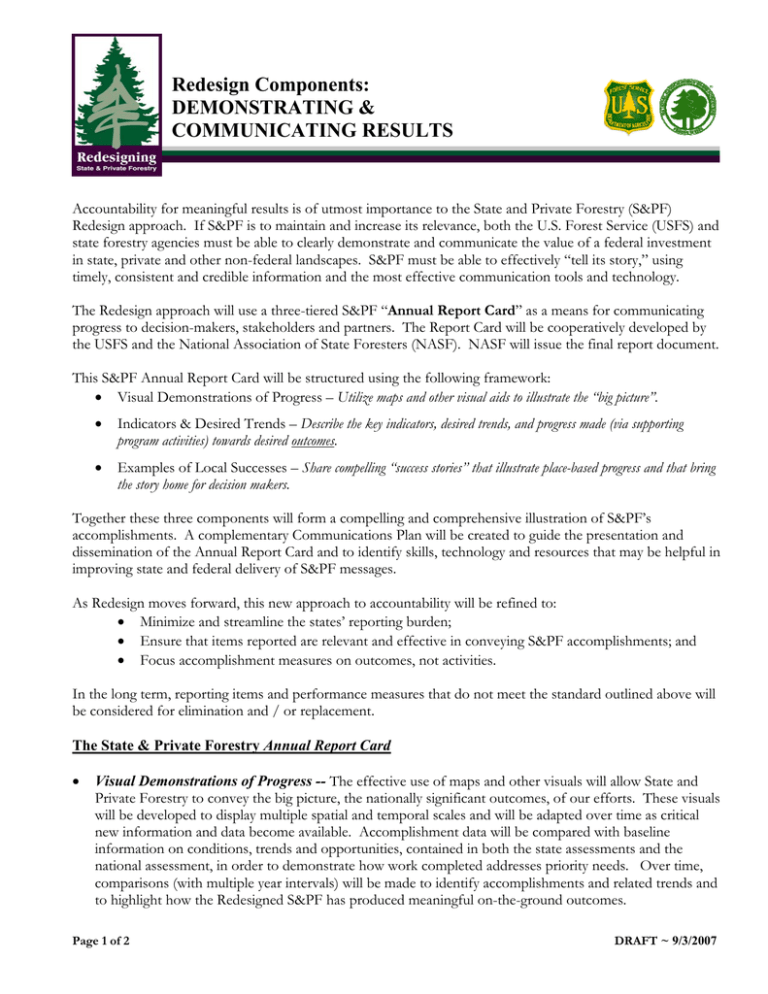
Redesign Components: DEMONSTRATING & COMMUNICATING RESULTS Accountability for meaningful results is of utmost importance to the State and Private Forestry (S&PF) Redesign approach. If S&PF is to maintain and increase its relevance, both the U.S. Forest Service (USFS) and state forestry agencies must be able to clearly demonstrate and communicate the value of a federal investment in state, private and other non-federal landscapes. S&PF must be able to effectively “tell its story,” using timely, consistent and credible information and the most effective communication tools and technology. The Redesign approach will use a three-tiered S&PF “Annual Report Card” as a means for communicating progress to decision-makers, stakeholders and partners. The Report Card will be cooperatively developed by the USFS and the National Association of State Foresters (NASF). NASF will issue the final report document. This S&PF Annual Report Card will be structured using the following framework: • Visual Demonstrations of Progress – Utilize maps and other visual aids to illustrate the “big picture”. • Indicators & Desired Trends – Describe the key indicators, desired trends, and progress made (via supporting program activities) towards desired outcomes. • Examples of Local Successes – Share compelling “success stories” that illustrate place-based progress and that bring the story home for decision makers. Together these three components will form a compelling and comprehensive illustration of S&PF’s accomplishments. A complementary Communications Plan will be created to guide the presentation and dissemination of the Annual Report Card and to identify skills, technology and resources that may be helpful in improving state and federal delivery of S&PF messages. As Redesign moves forward, this new approach to accountability will be refined to: • Minimize and streamline the states’ reporting burden; • Ensure that items reported are relevant and effective in conveying S&PF accomplishments; and • Focus accomplishment measures on outcomes, not activities. In the long term, reporting items and performance measures that do not meet the standard outlined above will be considered for elimination and / or replacement. The State & Private Forestry Annual Report Card • Visual Demonstrations of Progress -- The effective use of maps and other visuals will allow State and Private Forestry to convey the big picture, the nationally significant outcomes, of our efforts. These visuals will be developed to display multiple spatial and temporal scales and will be adapted over time as critical new information and data become available. Accomplishment data will be compared with baseline information on conditions, trends and opportunities, contained in both the state assessments and the national assessment, in order to demonstrate how work completed addresses priority needs. Over time, comparisons (with multiple year intervals) will be made to identify accomplishments and related trends and to highlight how the Redesigned S&PF has produced meaningful on-the-ground outcomes. Page 1 of 2 DRAFT ~ 9/3/2007 • Indicators and Desired Trends –A suite of indicators and corresponding desired trends will be established for each of the three S&PF Redesign themes as a means of assessing progress toward national priorities. In many cases, S&PF investments will be able to directly and measurably influence these indicators. This progress will be assessed using existing performance indicators whenever possible. • Demonstrations of Local Success -- Place-based “success stories” will be used as a third component of the Annual Report Card to effectively communicate the benefits of S&PF investments. Success stories provide more tangible outcomes to decision makers, enabling them to relate to people and places. These stories will be compelling examples of how citizens, communities and others are receiving technical and financial assistance that results in important public benefits over significant geographic areas (e.g., landscapes / watersheds / regional or multi-state areas). Distribution of success stories will be targeted to meet specific communication needs. Page 2 of 2 DRAFT ~ 9/3/2007
